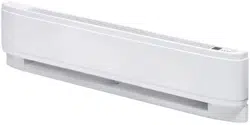
7211700100R18
Smart Baseboard
LPC Series
Placement of the Smart Baseboard
Smart Baseboards are high performance heaters designed
to operate at higher outlet temperatures than conventional
baseboard heaters. They can be directly mounted onto dry-
wall, plaster, wood or concrete walls. Due to the higher outlet
temperature, the wall surface can reach temperatures of 160º
F (71º C) or above and some materials may discolor or deform
at these temperatures, e.g. vinyl or plastic. In these cases the
heater can be mounted with an offset from the wall and oor to
reduce the temperature being applied to those materials. By
installing the heater with the provided Installation Optimizer
kit, the temperature of the wall above the heater can be re-
duced to 129º F (54º C).
!
NOTE: If the unit is being installed on a newly constructed
wall, ensure that all products that have been applied are
fully cured according to manufacturer’s instructions, before
operating the unit.
Recommendations for Locating Drapes and Fur-
niture near Heater (Figure 1)
!
NOTE: Any objects or materials that are located within the
distances outlined below should not discolor, nor distort
dimensionally (stretch or shrink) upon extended exposure (
up to 1000 hrs.) to temperatures of 200º F (93º C).
For most satisfactory operation of the heaters and minimum
effect on drapes, furniture and objects in close proximity, the
following recommendations should be observed:
1. Full Length Drapes: Hang drapes so there is at least 1.5”
(3.8 cm) between the top of the drapes and the ceiling, at
least 1.5” (3.8cm) between the bottom of the drapes and
the nished oor covering (such as carpet, if used) AND at
least 3” (7.6 cm) between the front vertical surface of the
heater and the nearest fold of the drapes (opened drape).
(Figure 1A)
2. Shorter Length Drapes: Hang drapes so there is at least
1.5” (3.8 cm) between the top of the drapes and the ceiling,
and at least 6” (15.2 cm), preferably more, between the
bottom of the drapes and the top horizontal surface of the
heater. (Figure 1B)
Installation Instructions
IMPORTANT INSTRUCTIONS
When using electrical appliances, basic precautions should al-
ways be followed to reduce the risk of re, electric shock and
injury to person, including the following:
1. Read all instructions before using this heater.
2. Heater and controls should be installed by a qualied con-
tractor. Wiring procedures and connections should be in
accordance with the National Electric Code (CEC & NEC)
and local codes.
3. A heater has hot and arcing or sparking parts inside. Do
not use it in areas where gasoline, paint or ammable liq-
uids are used or stored.
4. This heater is hot when in use. To avoid burns, do not let
bare skin touch hot surfaces. Keep combustible materials
such as: furniture, pillows, bedding, papers, clothes and
curtains away from heater.
5. To prevent a possible re, do not block air intakes or ex-
haust in any manner. Do not use on soft surfaces like a
bed where openings may become blocked.
6. Do not insert or allow foreign objects to enter any venti-
lation or exhaust opening as this may cause an electric
shock or re, or damage the heater.
7. Do not install these heaters against combustible, low den-
sity cellulose bre surfaces or vinyl wall paper.
8. Do not locate these heaters below any electrical conve-
nience receptacles.
9. Check nameplate ratings to be sure the heater voltage is
the same as the service supply. (The nameplate is located
below the right side of the heating element.)
10. HIGH TEMPERATURES: Keep electrical cords, furniture,
draperies or any other blocking material away from the
heater. See Installation Section for specic distances.
SAVE THESE INSTRUCTIONS
This equipment has been tested and found to comply with the
limits for a Class B digital device, pursuant to Part 15 of the
FCC Rules. These limits are designed to provide reasonable
protection against harmful interference in a residential instal-
lation. This equipment generates uses and can radiate radio
frequency energy and, if not installed and used in accordance
with the instructions, may cause harmful interference to radio
communications. However, there is no guarantee that interfer-
ence will not occur in a particular installation. If this equipment
does cause harmful interference to radio or television recep-
tion, which can be determined by turning the equipment off
and on, the user is encouraged to try to correct the interfer-
ence by one of the following measures:
• Reorient or relocate the receiving antenna.
• Increase the separation between the equipment and
receiver.
• Connect the equipment into an outlet on a circuit dif-
ferent from that to which the receiver is connected.
• Consult the dealer or an experienced radio/TV techni-
cian for help.
This device complies with Part 15 of the FCC Rules. Opera-
tion is subject to the following two conditions: (1) This device
may not cause harmful interference, and (2) this device must
accept any interference received, including interference that
may cause undesired operation.
FCC CAUTION: Any changes or modications not express-
ly approved by the party responsible for compliance could void
the user’s authority to operate this equipment.
This device complies with Industry Canada licence-exempt
RSS standard(s). Operation is subject to the following two
conditions: (1) this device may not cause interference, and (2)
this device must accept any interference, including interfer-
ence that may cause undesired operation of the device.
Loading ...
Loading ...
Loading ...
